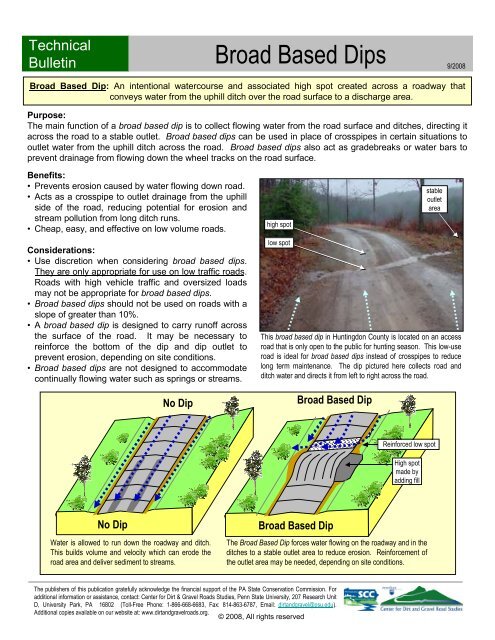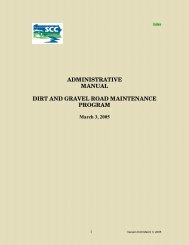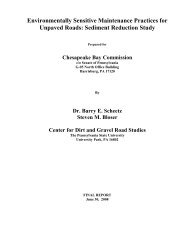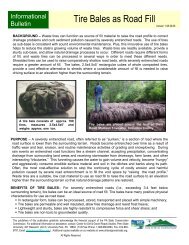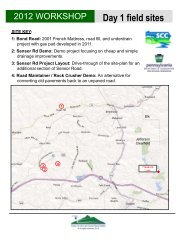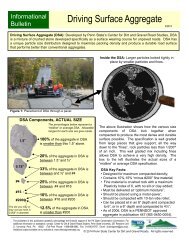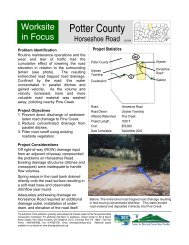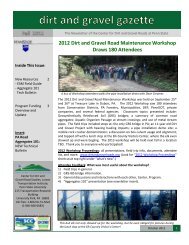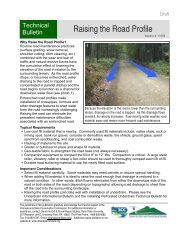Broad Based Dips - Center for Dirt and Gravel Road Studies - Penn ...
Broad Based Dips - Center for Dirt and Gravel Road Studies - Penn ...
Broad Based Dips - Center for Dirt and Gravel Road Studies - Penn ...
Create successful ePaper yourself
Turn your PDF publications into a flip-book with our unique Google optimized e-Paper software.
Technical<br />
Bulletin <strong>Broad</strong> <strong>Based</strong> <strong>Dips</strong> 9/2008<br />
<strong>Broad</strong> <strong>Based</strong> Dip: An intentional watercourse <strong>and</strong> associated high spot created across a roadway that<br />
conveys water from the uphill ditch over the road surface to a discharge area.<br />
Purpose:<br />
The main function of a broad based dip is to collect flowing water from the road surface <strong>and</strong> ditches, directing it<br />
across the road to a stable outlet. <strong>Broad</strong> based dips can be used in place of crosspipes in certain situations to<br />
outlet water from the uphill ditch across the road. <strong>Broad</strong> based dips also act as gradebreaks or water bars to<br />
prevent drainage from flowing down the wheel tracks on the road surface.<br />
Benefits:<br />
• Prevents erosion caused by water flowing down road.<br />
• Acts as a crosspipe to outlet drainage from the uphill<br />
side of the road, reducing potential <strong>for</strong> erosion <strong>and</strong><br />
stream pollution from long ditch runs.<br />
• Cheap, easy, <strong>and</strong> effective on low volume roads.<br />
Considerations:<br />
• Use discretion when considering broad based dips.<br />
They are only appropriate <strong>for</strong> use on low traffic roads.<br />
<strong>Road</strong>s with high vehicle traffic <strong>and</strong> oversized loads<br />
may not be appropriate <strong>for</strong> broad based dips.<br />
• <strong>Broad</strong> based dips should not be used on roads with a<br />
slope of greater than 10%.<br />
• A broad based dip is designed to carry runoff across<br />
the surface of the road. It may be necessary to<br />
rein<strong>for</strong>ce the bottom of the dip <strong>and</strong> dip outlet to<br />
prevent erosion, depending on site conditions.<br />
• <strong>Broad</strong> based dips are not designed to accommodate<br />
continually flowing water such as springs or streams.<br />
No Dip<br />
No Dip<br />
Water is allowed to run down the roadway <strong>and</strong> ditch.<br />
This builds volume <strong>and</strong> velocity which can erode the<br />
road area <strong>and</strong> deliver sediment to streams.<br />
high spot<br />
low spot<br />
<strong>Broad</strong> <strong>Based</strong> Dip<br />
<strong>Broad</strong> <strong>Based</strong> Dip<br />
The <strong>Broad</strong> <strong>Based</strong> Dip <strong>for</strong>ces water flowing on the roadway <strong>and</strong> in the<br />
ditches to a stable outlet area to reduce erosion. Rein<strong>for</strong>cement of<br />
the outlet area may be needed, depending on site conditions.<br />
The publishers of this publication gratefully acknowledge the financial support of the PA State Conservation Commission. For<br />
additional in<strong>for</strong>mation or assistance, contact: <strong>Center</strong> <strong>for</strong> <strong>Dirt</strong> & <strong>Gravel</strong> <strong>Road</strong>s <strong>Studies</strong>, <strong>Penn</strong> State University, 207 Research Unit<br />
D, University Park, PA 16802 (Toll-Free Phone: 1-866-668-6683, Fax: 814-863-6787, Email: dirt<strong>and</strong>gravel@psu.edu).<br />
Additional copies available on our website at: www.dirt<strong>and</strong>gravelroads.org. © 2008, All rights reserved<br />
This broad based dip in Huntingdon County is located on an access<br />
road that is only open to the public <strong>for</strong> hunting season. This low-use<br />
road is ideal <strong>for</strong> broad based dips instead of crosspipes to reduce<br />
long term maintenance. The dip pictured here collects road <strong>and</strong><br />
ditch water <strong>and</strong> directs it from left to right across the road.<br />
Rein<strong>for</strong>ced low spot<br />
High spot<br />
made by<br />
adding fill<br />
stable<br />
outlet<br />
area
high spot<br />
low spot<br />
<strong>Broad</strong> <strong>Based</strong> Dip – side view<br />
No dip: water flows down road & ditch<br />
<strong>Broad</strong> <strong>Based</strong> Dip: directs water off<br />
of roadway. Added fill prevents water<br />
from continuing down road <strong>and</strong> ditches.<br />
Amount <strong>and</strong> length of fill depends on road<br />
slope <strong>and</strong> intended use.<br />
A broad based dip is pictured here during a heavy rainstorm. Notice how gradual the dip would be to vehicles, yet how effectively road <strong>and</strong><br />
ditch flow is directed across the road. Without the dip, road <strong>and</strong> ditch drainage would continue to build erosive <strong>for</strong>ce around the corner.<br />
Construction Considerations:<br />
• SPACING: Multiple broad based dips can be used in sequence, similar to crosspipes, to drain a long<br />
stretch of road. Spacing <strong>for</strong> broad based dips depends on a variety of site-specific conditions including<br />
road slope, native soils, <strong>and</strong> hydrologic conditions.<br />
• SIZE & SHAPE: Sizing <strong>for</strong> broad based dips will vary widely depending mostly on road slope <strong>and</strong><br />
anticipated traffic. <strong>Dips</strong> constructed on flat roads may be relatively small (fill transitions as short as 12<br />
feet <strong>and</strong> as low as 6 inches). <strong>Dips</strong> installed on steeper sections of road will require more “approach fill” to<br />
ease the transition into <strong>and</strong> out of the structure (fill transitions over 100 feet long <strong>and</strong> up to 18 inches<br />
deep). Be sure to take anticipated traffic into account. The dip pictured on the front of this document is<br />
on a gated access road <strong>and</strong> is much more abrupt. The dip pictured above has much smoother transitions<br />
to accommodate cars <strong>and</strong> log trucks. A relatively wide dip bottom is recommended to accommodate<br />
water <strong>and</strong> ease vehicle transitions. The upslope end of the dip should be tied into the uphill bank to<br />
insure water does not bypass the structure <strong>and</strong> continue flowing down the ditch.<br />
• ANGLE: <strong>Broad</strong> based dips should be angled across the road at approximately 20-40 degrees, not placed<br />
at 90 degrees perpendicular to the road like a speed bump. The angle will facilitate the flow of water<br />
across the road. A dip placed straight across the road will be much more likely to fail because it <strong>for</strong>ces<br />
water to turn at a right angle to flow across the roadway.<br />
• SLOPE: Similar to crosspipes, the bottom of a broad based dip should have an elevation drop towards<br />
the outlet end. A 3% slope is recommended across the bottom of the dip<br />
• DIP REINFORCEMENT: Because a broad based dip is designed to carry concentrated flow on the<br />
surface of the road, rein<strong>for</strong>cement of the dip bottom is recommended. Hard stone <strong>and</strong> even geo-synthetic<br />
materials can be used to rein<strong>for</strong>ce the bottom of the dip to resist erosion.<br />
• OUTLET REINFORCEMENT: Because a broad based dip outlets water similar to a crosspipe, similar<br />
outlet stability concerns apply. When possible, outlet dips into a vegetated buffer area. Depending on<br />
the amount of water <strong>and</strong> slope of the l<strong>and</strong>, additional outlet stabilization with stone may be required.<br />
• MAINTENANCE: A properly constructed broad based dip will function <strong>for</strong> years with minimal<br />
maintenance. Care must be taken not to remove the dip during any future maintenance activity.<br />
<strong>Broad</strong> based dips are a cheap <strong>and</strong> effective means of drainage control on low volume roads. Farm lanes,<br />
camp roads, gated access roads, <strong>and</strong> other low use roads are ideal c<strong>and</strong>idates <strong>for</strong> these structures.<br />
Always try to discharge dips to a stable outlet away from streams.<br />
*A Gradebreak is a related surface drainage structure designed to divert water off the road surface, but not to carry flowing water<br />
across the road. For details about gradebreaks, see the <strong>Center</strong>’s related technical bulletin at www.dirt<strong>and</strong>gravelroads.org.<br />
This publication is available in alternative media upon request. The <strong>Penn</strong>sylvania State University is committed to the policy that all persons shall have equal access to programs,<br />
facilities, admission, <strong>and</strong> employment without regard to personal characteristics not related to ability, per<strong>for</strong>mance, or qualification as determined by University policy or by state or<br />
federal authorities. The <strong>Penn</strong>sylvania State University does not discriminate against any person because of age, ancestry, color, disability or h<strong>and</strong>icap, national origin, race,<br />
religious creed, sex, sexual orientation, or veteran status. Direct all affirmative action inquiries to the Affirmative Action Office, The <strong>Penn</strong>sylvania State University, 201 Willard<br />
Building, University Park, PA 16802-2801; tel. (814) 863-0471; TDD (814) 865-3175. U.Ed #RES-01-50.<br />
stable<br />
outlet<br />
area<br />
water flow<br />
water flow<br />
Imported fill


